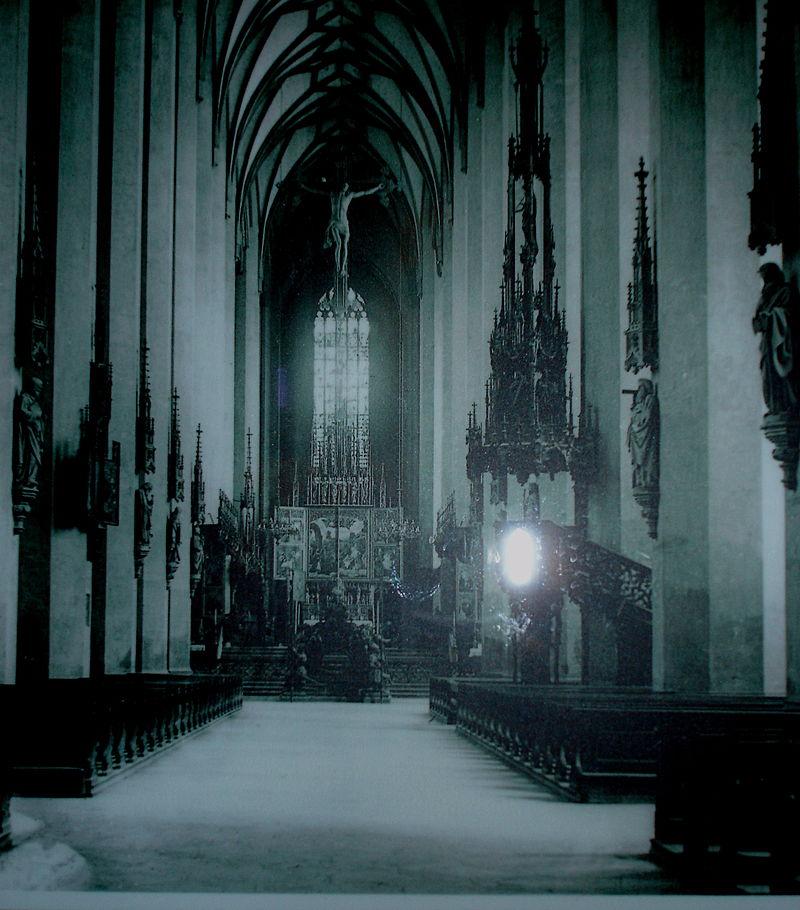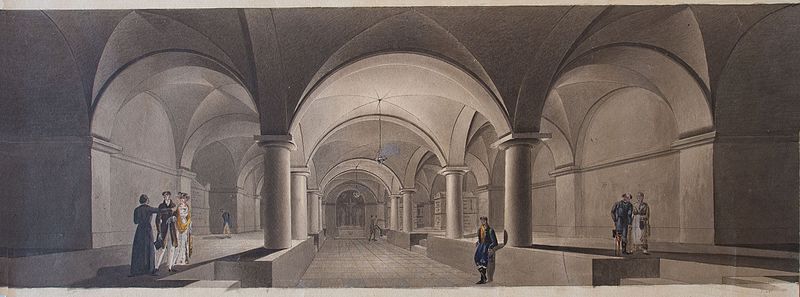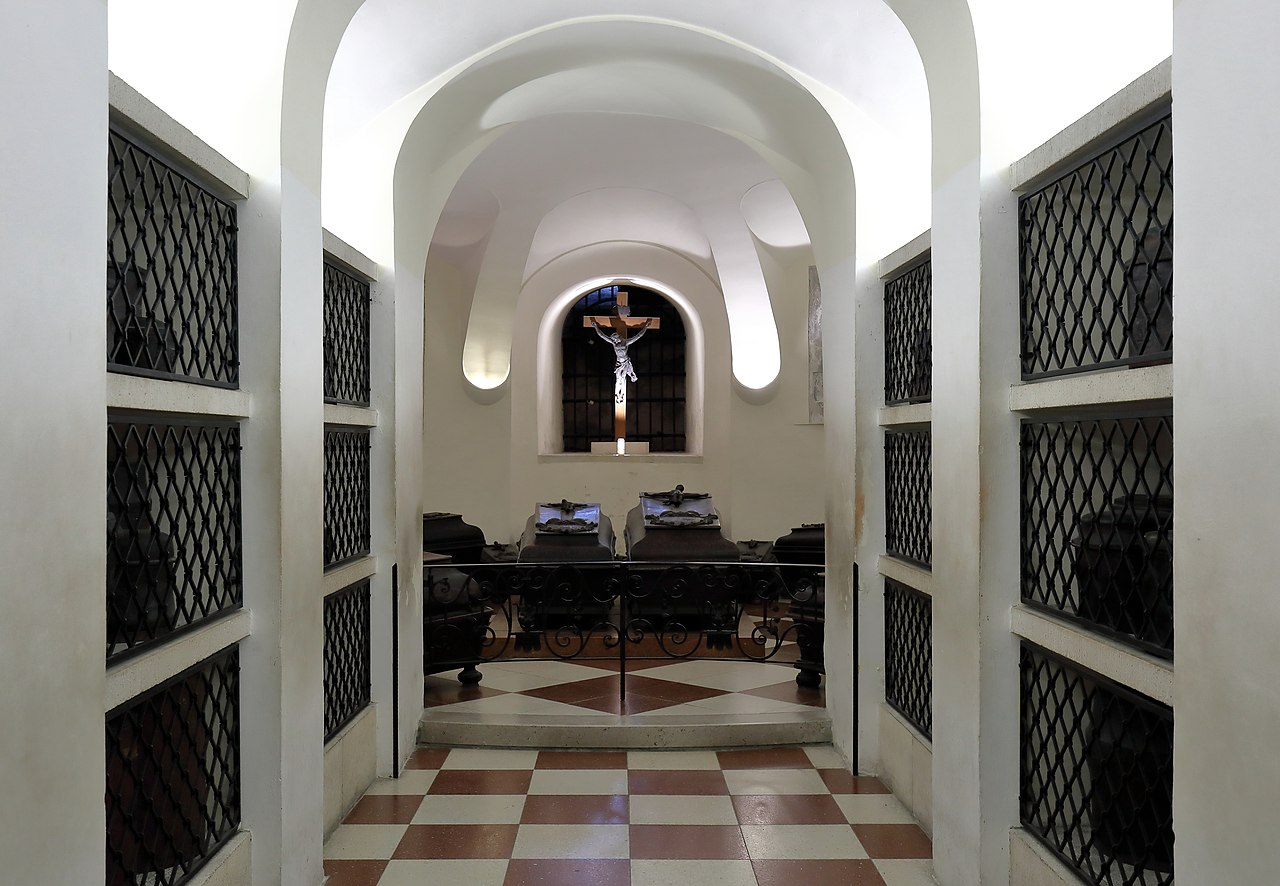by Susan Flantzer
© Unofficial Royalty 2022

Frauenkirche in Munich, Bavaria, Germany; By Diliff – CC BY 2.5, https://commons.wikimedia.org/w/index.php?curid=5825439
- Official Website: Der Münchner Dom (in German)
The Frauenkirche (Church of Our Lady) also called Münchner Dom (Munich Cathedral), which this writer has visited, is a Roman Catholic church and the cathedral church of the Archbishop of Munich located in Munich, the capital of the German state of Bavaria.

Frauenkirche in 1870 looking toward the main altar; Credit – Wikipedia
In the 12th century, a Romanesque church was built on the site replacing an earlier church. This new church served as a second parish in Munich following the older Alter Peter Church. A new late Gothic cathedral commissioned by Sigismund, Archduke of Austria and the people of Munich, was erected in the 15th century. The cathedral was built from 1468 – 1488 by bricklayer and architect Jörg von Halsbach. Red brick was chosen as the building material for financial reasons and because there was no nearby rock quarry. The cathedral was consecrated In 1494 but the towers were not completed until 1525.

Frauenkirche in ruins after World War II. The steps led to the main altar; Credit – https://www.muenchner-dom.de/die-kathedrale/geschichte/baugeschichte/
The Frauenkirche was severely damaged by the Allied Forces’ bombing raids during World War II. The roof collapsed, one of the towers was damaged, and much of the interior was destroyed. A major restoration was required and continued until 1994.

Interior of the restored Frauenkirche looking towards the main altar; Credit – By Chabe01 – Own work, CC BY-SA 4.0, https://commons.wikimedia.org/w/index.php?curid=64107752
From 1971 – 1972 the main altar area was redesigned according to the reforms and specifications of the Second Vatican Council. From 1989 – 1994, the interior decorations of the original architect Jörg von Halsbach and the oak choir stalls with the sculptures of the original sculptor Erasmus Grasser were reconstructed and new altarpieces were created. Artwork from notable 14th to 18th-century artists like Peter Candid, Erasmus Grasser, Jan Polack, Hans Leinberger, Hans Krumpper, and Ignaz Günther replaced the artwork destroyed in the World War II bombing raids.

The main altar; Credit – By © José Luiz Bernardes Ribeiro, CC BY-SA 4.0, https://commons.wikimedia.org/w/index.php?curid=62161379
********************
Cenotaph of Ludwig IV, Holy Roman Emperor
A cenotaph, an empty tomb erected in honor of a person whose remains are elsewhere, for Ludwig IV, Holy Roman Emperor who died in 1347, stands in the south aisle. The remains of Ludwig IV, Holy Roman Emperor are interred in the Frauenkirche crypt. The cenotaph was the work of sculptor Hans Krumpper (circa 1570 – 1634) who was the chief sculptor to the Bavarian court during the reigns of Wilhelm V, Duke of Bavaria and Maximilian I, Duke of Bavaria. During the World War II-related restoration of the Frauenkirche in the 1980s, the cenotaph was restored with financial help from the Messerschmitt Foundation whose primary goal is the preservation and maintenance of German cultural monuments.
********************
The Crypt

The 1971 crypt in the Frauenkirche; Credit – By User: Bbb at wikivoyage shared, CC BY-SA 1.0, https://commons.wikimedia.org/w/index.php?curid=22660042
The crypt we see today was created in 1971 when a larger crypt with exposed brick walls and a concrete beam ceiling was built during World War II-related reconstruction. The coffins of members of the Bavarian House of Wittelsbach were then transferred to new wall niches with grave markers. The House of Wittelsbach ruled as Dukes, Electors, and Kings of Bavaria from 1180 until 1918.
Besides the Frauenkirche, rulers of the House of Wittelsbach have mostly been interred at the Theatinerkirche St. Kajetan (Theatine Church of St Cajetan) in Munich and Michaelskirche (St. Michael’s Church) in Munich, and the Andechs Monastery in Andechs. In 1977, Albrecht, Duke of Bavaria, head of the House of Wittelsbach and pretender to the former Bavarian throne from 1955 until his death in 1996, set up a Wittelsbach family cemetery near Andechs Abbey due to the lack of space in the other Wittelsbach burial sites. The cemetery complex is now the main burial place of the Wittelsbach family.

Burial site of some members of the House of Wittelsbach; Credit – By © José Luiz Bernardes Ribeiro, CC BY-SA 4.0, https://commons.wikimedia.org/w/index.php?curid=62160767
The following members of the House of Wittelsbach are interred in the crypt:
-
- Beatrix of Silesia, Duchess of Bavaria, Queen of the Romans (1290 – 1322) – first wife of the future Ludwig IV, Holy Roman Emperor
- Ludwig IV, Holy Roman Emperor (1282 – 1347)
- Ludwig of Bavaria (1347 – 1348) – son of Ludwig IV, Holy Roman Emperor
- Elisabeth of Sicily, Duchess of Bavaria (1310 – 1349) – first wife of Stephan II, Duke of Bavaria
- Agnes of Bavaria (1335 – 1352) – daughter of Ludwig IV, Holy Roman Emperor, Poor Clare nun
- Ludwig V, Margrave of Brandenburg, Duke of Bavaria (1315 – 1361)
- Margarethe of Bavaria, Duchess of Croatia (1325 – 1374) – daughter of Ludwig IV, Holy Roman Emperor
- Stephan II, Duke of Bavaria (1316 – 1375)
- Margarethe of Nuremberg, Duchess of Bavaria (1333 – 1377) – second wife of Stephan II, Duke of Bavaria
- Johann II, Duke of Bavaria-Munich (1341 – 1397)
- Elisabeth Visconti, Duchess of Bavaria-Munich (1374 – 1432) – wife of Ernst, Duke of Bavaria
- Wilhelm III, Duke of Bavaria-Munich (1375 – 1435)
- Ernst, Duke of Bavaria-Munich (1373 – 1438)
- Adolf, Duke of Bavaria-Munich (1434 – 1441)
- Barbara of Bavaria-Munich (1454 – 1472) – daughter of Albrecht III, Duke of Bavaria, Poor Clare nun
- Susanna of Bavaria (1499 – 1500) – daughter of Albrecht IV, Duke of Bavaria
- Siegmund, Duke of Bavaria-Munich (1439 – 1501)
- Sidonie of Bavaria (1488 – 1505) – daughter of Albrecht IV, Duke of Bavaria
- Albrecht IV, Duke of Bavaria (1447 – 1508)
- Kunigunde of Austria, Duchess of Bavaria (1465 – 1520) – first wife of Albrecht IV, Duke of Bavaria
- Wilhelm of Bavaria (1529 – 1530) – son of Wilhelm IV, Duke of Bavaria
- Susanna of Bavaria, Margravine of Brandenburg-Bayreuth, Countess Palatine of Neuburg (1502 – 1543) – daughter of Albrecht IV, Duke of Bavaria
- Wilhelm IV, Duke of Bavaria (1493 – 1550)
- Ernst of Bavaria, Administrator of Salzburg and Passau, Pledger of the County of Glatz (1500 – 1560) – son of Albrecht IV, Duke of Bavaria
- Albrecht V, Duke of Bavaria (1528 – 1579)
- Marie Jakobaea of Baden-Sponheim, Duchess of Bavaria (1507 – 1580), wife of Wilhelm IV, Duke of Bavaria
- Anna of Austria, Duchess of Bavaria (1528 – 1590) – wife of Albrecht V, Duke of Bavaria
- Philipp Wilhelm of Bavaria, Cardinal-Archbishop of Regensburg (1576 – 1598) – son of Wilhelm V, Duke of Bavaria
- Ferdinand of Bavaria (1550 – 1608) – son of Albrecht V, Duke of Bavaria
- Maximiliana Maria of Bavaria (1552 – 1614) – daughter of Albrecht V, Duke of Bavaria
- Maria Pettenbeck (1573 – 1619) – morganatic wife of Ferdinand of Bavaria, son Albrecht V, Duke of Bavaria; the sixteen children of this marriage were raised to the status of Counts and Countesses of Wartenberg
- Count Albert von Wartenberg (1601 – 1620) – son of Ferdinand of Bavaria and grandson of Albrecht V, Duke of Bavaria
- Countess Maria Renata von Wartenberg (1616 – 1630) – daughter of Ferdinand of Bavaria and granddaughter of Albrecht V, Duke of Bavaria, nun
- Karl Johann Franz of Bavaria (1618 – 1640) – son of Albrecht VI, Duke of Bavaria
- Countess Anna Juliana von Wartenberg (1611 – 1650) – granddaughter of Ferdinand of Bavaria and great-granddaughter of Albrecht V, Duke of Bavaria
- Countess Maria Claudia von Wartenberg (1632 – 1663) – granddaughter of Ferdinand of Bavaria and great-granddaughter of Albrecht V, Duke of Bavaria
- Count Ferdinand Ernst von Wartenberg (1630 – 1675) – son of Count Ernst Benno von Wartenberg and grandson of Albrecht V, Duke of Bavaria
- Count Ferdinand Marquard von Wartenberg (1673 – 1730), son of Count Johann Ferdinand von Wartenberg, grandson of Count Ernst Benno von Wartenberg and great-grandson of Albrecht V, Duke of Bavaria
- Princess Maria Anna of Bavaria (1696 – 1750) – daughter of Maximilian II Emanuel, Elector of Bavaria, Poor Clare nun
- Princess Notburga of Bavaria (born and 1883) – daughter of Ludwig III, King of Bavaria
- Princess Dietlinde of Bavaria (1888 – 1889) – daughter of Ludwig III, King of Bavaria
- Prince Wolfgang of Bavaria (1879 – 1895) – son of Ludwig III, King of Bavaria
- Marie Therese of Austria-Este, Queen of Bavaria (1849 – 1919) – wife of Ludwig III, King of Bavaria
- Ludwig III, King of Bavaria (1845 – 1921)
- Prince Karl of Bavaria (1874 – 1927) – son of Ludwig III, King of Bavaria
- Princess Hildegard of Bavaria (1881 – 1948) – daughter of Ludwig III, King of Bavaria, unmarried

Burial site of Ludwig III, the last King of Bavaria, his wife and five of their children; Photo Credit – © Susan Flantzer
This article is the intellectual property of Unofficial Royalty and is NOT TO BE COPIED, EDITED, OR POSTED IN ANY FORM ON ANOTHER WEBSITE under any circumstances. It is permissible to use a link that directs to Unofficial Royalty.
Works Cited
- De.wikipedia.org. 2021. Frauenkirche (München) – Wikipedia. [online] Available at: <https://de.wikipedia.org/wiki/Frauenkirche_(M%C3%BCnchen)> [Accessed 29 December 2021].
- En.wikipedia.org. 2021. Munich Frauenkirche – Wikipedia. [online] Available at: <https://en.wikipedia.org/wiki/Munich_Frauenkirche> [Accessed 29 December 2021].
- Muenchner-dom.de. 2021. Der Münchner Dom: Baugeschichte. [online] Available at: <https://www.muenchner-dom.de/die-kathedrale/geschichte/baugeschichte/> [Accessed 29 December 2021].
- Muenchner-dom.de. 2021. Der Münchner Dom: Home. [online] Available at: <https://www.muenchner-dom.de/> [Accessed 29 December 2021].

























































